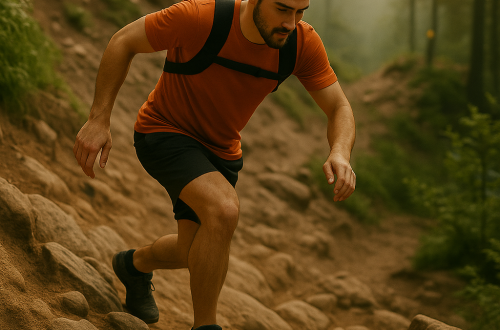
What’s the best way to pace yourself on a trail run?
Why Pacing Matters on the Trails
On her first mountain trail race, Alyssa, a confident half-marathoner, charged up the first hill like it was a 5K. By mile three, she was lightheaded, her legs buckled, and she spent the rest of the run walking while others steadily passed. “I didn’t realize how different trail running pace was,” she later said.
That’s the core truth: trail running pace isn’t about holding steady splits—it’s about adapting. Trail running is a balance of endurance, strength, and presence. Every hill, rock, or muddy turn asks your body to respond. The art of pacing on the trail is less about numbers and more about flow, control, and decision-making.
The Key Differences Between Road and Trail Running Pace
Imagine you’re used to running 8-minute miles on pavement. Then you hit a singletrack trail with 1,000 feet of elevation gain, switchbacks, and loose gravel. Suddenly, a 13-minute mile feels hard—and that’s normal.
Here’s why trail running pace is so variable:
-
Terrain variability: Roots, rocks, sand, and mud all affect footing and rhythm.
-
Elevation gain: Steep climbs dramatically reduce speed and increase effort.
-
Technical complexity: Slowing down to navigate descents or creek crossings is smart, not weak.
-
Weather and surface conditions: Wet or hot conditions make pace a moving target.
That’s why most trail runners learn to measure progress by time on feet or effort—not pace per mile.
How to Set a Realistic Trail Running Pace
Your ideal trail running pace begins with preparation.
Before one of his first 15K trail events, James, a new trail runner, spent hours studying the course profile. He saw two major climbs and decided to break the run into three effort zones: hold back on the flats, power hike the climbs, and cruise the downhills. He finished strong, even passing faster runners in the last stretch.
What made the difference?
-
Course intel: Study elevation maps. Use tools like Gaia GPS or AllTrails.
-
Effort-based mindset: Let your breathing and perceived effort guide you.
-
Hike breaks: Plan when to power hike. It’s strategic energy conservation, not giving up.
A “slow” start can be the smartest move. The trails will demand your energy—don’t spend it all early.
Perceived Effort vs. GPS Pace: Trusting Your Body
Your GPS watch might say 15:00/mile on a climb, then 7:30 on a downhill. But did those numbers really reflect your effort?
Perceived effort—the internal measure of how hard you feel you’re working—is often more reliable. Here’s a simple effort scale many trail runners use:
-
1–3: Very easy. You could chat or sing.
-
4–6: Sustainable. You can talk, but with effort.
-
7–8: Hard. Focused effort. Limited speech.
-
9–10: All out. Save for sprints or emergencies.
Experienced trail runners like Clara train without pace goals. “I listen to my breath and legs,” she says. “If I can’t smile or talk a little, I back off.”
Adapting Your Pace for Hills and Descents
On trails, no two miles are the same. The key is to adjust your trail running pace without ego.
Going Uphill?
-
Shorten your stride: Think quick, light steps.
-
Use your arms: Drive your rhythm uphill.
-
Power hike if needed: When your breathing spikes, hiking saves energy and isn’t slower.
Heading Downhill?
-
Stay light and controlled: Let gravity assist, but don’t crash.
-
Lean forward slightly: It’s safer and keeps momentum smooth.
-
Arms out for balance: Your arms act like stabilizers.
After a steep downhill, give yourself a moment to recalibrate before pushing hard again. Your quads will thank you.
How to Pace Yourself During Long Trail Runs
Whether it’s a 10K or 50K, long trail runs are a different mental game. Energy fades, terrain changes, and small mistakes compound.
-
Start slower than you think: The first hour should feel easier than expected.
-
Fuel early and often: Eating small amounts every 45–60 minutes keeps you from crashing.
-
Mentally segment the trail: Use landmarks, aid stations, or loops as checkpoints.
-
Read your body: Adjust based on how you feel—not just what your watch says.
A fellow runner, Rachel, used this strategy for her first 25K. “Instead of pushing through every section, I gave myself permission to walk, eat, or just take in the view. I didn’t just survive—I enjoyed it.”
Tools and Tech to Help You Pace Smarter
Technology can help—if you don’t let it boss you around.
-
GPS watches: Use them for tracking distance and elevation, but don’t obsess over pace.
-
Heart rate monitors: Helpful for staying in your aerobic zone on climbs.
-
Trail apps: Preview segments, water stops, and difficulty ratings.
-
Running power meters: For the data-driven, power offers terrain-adjusted effort metrics.
Just remember: your best data source is your own body. Use tech for feedback, not validation.
Common Pacing Mistakes to Avoid
Even seasoned runners sometimes get it wrong. Don’t fall for these traps:
-
Starting too fast: Especially common in races—don’t chase others’ pace.
-
Ignoring terrain: Your road speed doesn’t apply here.
-
Obsessing over GPS data: In canyons or forests, signals lie.
-
Forcing a run when a hike is smarter: Listen to fatigue, especially late in the run.
-
Skipping recovery after hard terrain: Give your legs a breather.
Every trail run is an opportunity to practice pacing. Each time, you’ll learn something new.
Final Thoughts: Run with Intention, Not Just Speed
Trail running pace isn’t about how fast you can go—it’s about how well you adapt. It’s how you move through the environment, read your energy, and respond to the terrain. It’s both physical and emotional.
The best trail runners don’t fight the trail—they partner with it. They slow down when it’s steep, speed up when it’s smooth, and pause when the view steals their breath.
So next time you’re on the trail, forget the numbers. Focus on your rhythm, your breath, and the joy of moving freely. That’s the pace that truly matters.
Powered by: aiContent.live





